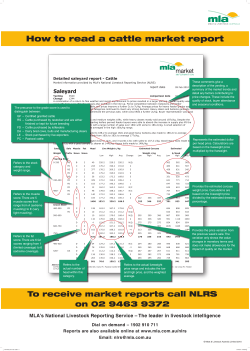
• Cloudiness forming in the middle of the eye.
• • • • • Cloudiness forming in the middle of the eye. Ulceration of the eye, sometimes releasing an odour and pus (Figure 2). Blindness, disorientation of surroundings. Loss of body weight in young cattle. Death in rare, severe cases due to accidents, starvation or thirst. Livestock Factsheet »» Pinkeye What is pinkeye? Pinkeye or infectious bovine keratoconjunctivitis, is an infection of the eye caused by the bacterium, Moraxella bovis. The bacterium produces a toxin that causes aggressive inflammation of the eye, often resulting in short term or permanent blindness in cattle. Pinkeye, a contagious disease, can affect up to 80% of a mob usually affecting young cattle during the summer and autumn months in Victoria. Young cattle can lose up to 10% of their body weight as a result of infection. The disease has the potential to cause economic loss through lower body weights, reduced milk production in cows and reduced marketing opportunities. Feedlotters and re-stockers are usually reluctant to buy cattle that are blind; as not only can it affect the animal’s performance it also poses a safety hazard when handling stock. Pinkeye is not a notifiable disease in Australia. Figure 1. Watery discharge from the eye is usually the first stage of pinkeye Picture courtesy of DPI New South Wales. Is my herd susceptible? There are a number of factors that increase the susceptibility of cattle to pinkeye. These factors include: • Genetic composition; animals with a low level of pigment around their eyes, protruding or unhooded eyes are generally more at risk. • Breed; British and European breeds are more vulnerable to the disease than Bos Indicus cattle. Whiteface cattle e.g. Herefords or Hereford-cross cattle tend to be more susceptible. • Flies which feed on the infected secretions from the eye and transfer disease to clean cattle. • Dusty conditions which aggravate the eye predisposing the animal to pinkeye. • High ultraviolet radiation. • Physical irritation of the eye by thistles or long grass. Infective discharge from the eye can also spread onto long grass, transferring to clean cattle in the mob. • Cattle that have been previously infected can develop short-term immunity, of up to a year, following infection. Continual exposure to the causative agents prolongs immunity. What are the signs? Clinical signs of pinkeye include: • Weepy eyes with an abundance of watery discharge coming from the eye. This is usually the first sign of infection (Figure 1). • Indications of eye irritation, such as excessive blinking. • Intolerance to sunlight. • Inflammation and swelling of the third eyelid. Figure 2. Severe inflammation of the eye as a result of pinkeye. Picture courtesy of DPI New South Wales. Treatment of pinkeye Cattle typically recover from pinkeye without treatment, 3-5 weeks after infection. However, scarring and partial blindness may remain and in severe cases complete blindness. Mustering cattle solely for the purpose of treating pinkeye may be impractical in some situations. Dust stirred by mustering may worsen the problem rather than aid in the treatment of infection. The possibility of further spread should be considered, regarding the percentage of infected stock in the mob. Producers should aim to treat any eye infections when animals are yarded for vaccination, drenching or other treatments. There are a number of antibiotic treatments available from your local veterinary. Producers should handle and store treatments according to label recommendations. Different treatments available include: • Ointments; administered under the upper and lower eyelids, into the • • • conjunctival sac. In mild cases only a single application is required, lasting up to 48 hours. In persistent cases a second dose will need to be given at least 48 hours following initial treatment. Powder and sprays; offering short-term treatment and often requiring continual application to be effective. An injectable antibiotic and anti-inflammatory drug for use in severe cases. This form of treatment is more expensive. The solution is injected into the third eyelid of the infected eye and head restraint is required. In some cases a veterinarian may need to carry out this procedure. This method can be combined with another antibiotic treatment such as ointment to increase the rate of recovery. Eye patches are recommended for use to improve the effectiveness of antibiotic treatments. They are not effective on their own. Eye patches ease the pain to the animal as result of direct exposure to sunlight and reduces irritation to the eye from dust, long grass and flies. Further Links Department of Primary Industries Victoria http://www.dpi.vic.gov.au/agriculture/beef-and-sheep/beef/beefhealth-and-welfare/pink-eye-beef-cattle Department of Primary Industries New South Wales http://www.dpi.nsw.gov.au/__data/assets/pdf_file/0017/103904/ pinkeye-in-cattle.pdf Coopers Animal Health http://www.pinkeye.com.au/ Original Author, Jacinta Pretty (VFF Livestock Project Officer), Original Version Published in November 2012. Prevention Vaccinating susceptible young stock with Cooper’s Piliguard®. The vaccine blocks the attachment of the Moraxella bacteria to the cornea of the eye preventing the establishment of pinkeye. The vaccine requires a single 2ml dose administered 3-6 weeks prior to the commencement of the pinkeye season. Annual revaccination at the beginning of the pinkeye season is required to maintain protection. Producers should handle and store treatments according to label recommendations. • Reduce the incidence of flies and subsequent spreading of bacteria with the application of pour-on treatments. • Early detection, segregation and treatment of infected stock. • When selecting whiteface cattle for breeding purposes, choose cattle with pigment around their eyes. • Avoid excessive yarding in dusty yards during the pinkeye season. Disclaimer: The Victorian Farmers Federation (VFF), its partners, agents and contractors do not guarantee that this publication is without flaw and do not accept any liability whatsoever for any errors, defects or omissions in the information provided. This publication is intended for general information purposes only and does not constitute financial, legal, investment, production or marketing advice. The VFF excludes all liability for any loss or damage of any kind arising in relation to this publication including any reliance on the information contained herein. For further information, please contact the VFF Livestock Group on 1300 882 833 or by email to Jacinta Pretty at jpretty@vff.org.au Victorian Farmers Federation Farrer House, Level 5, 24 Collins St Melbourne, Victoria, 3000 Telephone: 1300 882 833 Fax: 03 9207 5500 VFF@VFF.org.au www.VFF.org.au
© Copyright 2025





















